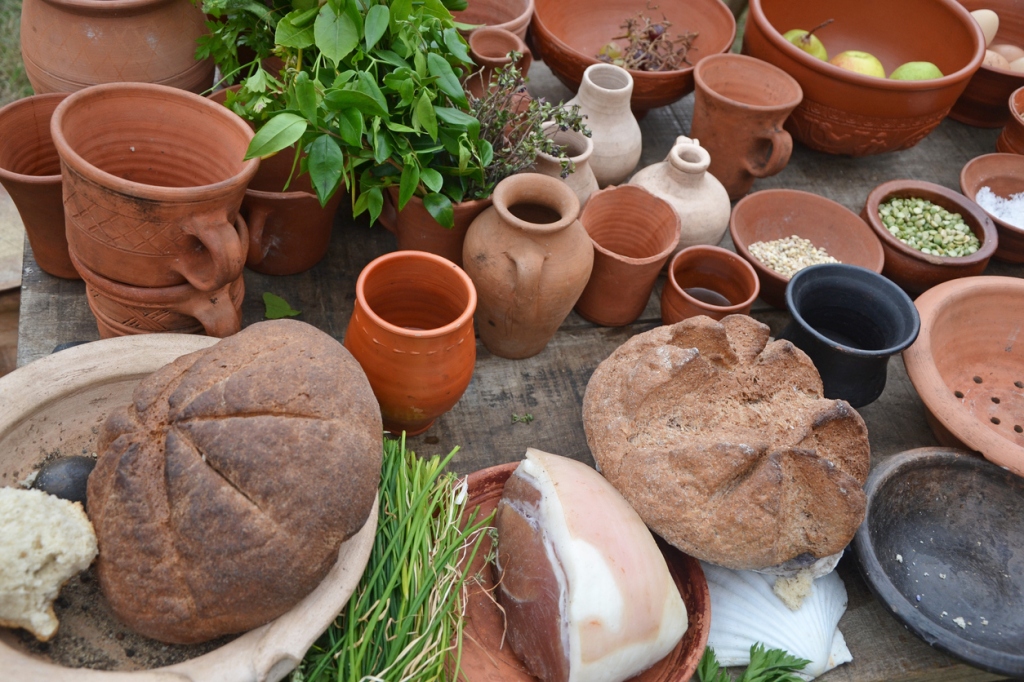In the last blog, I looked at what we know about food and drink in the Anglo-Saxon period. In many ways it might seem to us today that the Anglo-Saxon diet was healthy: no sugar, no fast foods, no ready meals, no additives, no processed foods – all the things dietitians and nutritionists are concerned about these days. So we tend to make assumptions based on our 21st century perspectives of a ‘healthy diet’ or ‘unhealthy foods’. We don’t have the Anglo-Saxon perspective on this!
The paucity of skeletal evidence from bio-archaeological or osteo-archaeological findings make it difficult to assess disease and chronic illnesses of the period. Our assumptions might be that there was lower incidence of obesity, heart disease, cancers because the diet consisted for many people of fresh fruit and vegetables, cereals, fresh meat and fish (although the latter two were more prevalent in the diet of the higher status Anglo-Saxons). And we might assume that this would lead to an increase in dental health, average height, increased recovery rate from infections. But without documentary or widespread archaeological evidence it’s hard to make generalisations.
We do know that there would have been a reliance on seasonal fresh produce because preservation was hard, which could be a problem if the harvest was affected by climate or major weather systems and this would be a vulnerability for Anglo-Saxon settlements. For example, there is evidence of a major volcanic eruption in the mid-530s which caused significant climate change, cold, darkness, ruined harvests. The resulting famine, hunger and starvation, would result in increased disease and deaths. We also know that there was a significant pandemic of bubonic plague in 541-2. Although this may not have been caused by diet it would certainly have ramifications on food production and availability.
The lack of food preservation techniques would exacerbate this vulnerability. There were few means to preserve perishable foodstuffs, apart from drying, smoking, and salting. Salt became such a precious commodity that some might be paid in salt, and social status was marked by how near or far you sat from the salt at feasts (‘above or below the salt’ was a common expression, being ‘below the salt’ indicating lower status). Foods such as fish and meat would be encased in salt for preservation, but it was also used to mask the taste of bad food.
Rotten perishable food was a significant health risk, but it was arguably not entirely widely recognised in this period. We think that it tended to be thought that it was the taste of bad food that was the problem, rather than the bacteria in rotting food. So, as a result, the Anglo-Saxons were keen to disguise the taste of bad food with salt, herbs and marinades. There would have been a significant risk of illness from food poisoning, from meat from cattle that were carriers of disease, and a weakening of strength when physical activity was paramount for the life of the community.
What about Anglo-Saxon medicine? Bald’s Leechbook (9th century) available in the British Library, and other documents, provide some interesting evidence of the way illness and disease was treated in this period. For example, various treatments were advised for wounds, throat infections, skin conditions and some for more serious diseases. Herbs were used for infusions, ointments, salves and poultices (eg an eye salve from garlic), and recipes are given for problems such as nettles for muscular pain. Eating animal liver is cited as a ‘cure for the plague’. The Leechbook suggests a concoction of leek, garlic, wine and bullock’s gall, which was reported in 2015 as a potion that could potentially kill methicillin-resistant staphylococcus aureus (MRSA)!
A final thought: there is emerging evidence from Anglo-Saxon sites in Cambridgeshire and Kent from the analysis of human skeletal remains for carbon and nitrogen isotopes that suggest diverse diets based on wealth and social status. For example, some studies suggest that higher status, wealthier Anglo-Saxons ate more meat and fish, and lower status people ate more vegetables, and possibly were, in some case, largely vegetarian. This is an ongoing analysis, but it would be interesting to know whether this related to the level of health.
PS Would you like to know more about life in the Anglo-Saxon period? My novel A Shape on the Air is set in 499 AD as Angle and Saxon tribes began to settle in Britain, although of course this happened over the course of several centuries.



You must be logged in to post a comment.